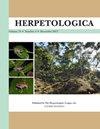Is Color Related to Parasite Load in a Sexually Dichromatic Neotropical Toad?
IF 1.1
3区 生物学
Q2 ZOOLOGY
引用次数: 1
Abstract
Abstract: Research on anuran parasites often focuses on the description and identification of parasites and demonstrating that parasitic infection can have deleterious effects on the health of amphibians. There is comparatively little research on how parasitism influences evolutionary dynamics such as sexual selection. Here, we explore anuran blood parasites with a focus on parasite-mediated sexual selection. The Hamilton–Zuk hypothesis posits that parasite–host coevolution drives sexual ornamentation of hosts, and that the degree of ornament expression honestly signals heritable parasite resistance. Although the Hamilton–Zuk hypothesis has received support in a number of animal taxa, it has received little attention in amphibians. Neotropical Yellow Toads (Incilius luetkenii) are sexually dichromatic toads with an unusual sexual ornament: males turn from cryptic brown to bright lemon yellow for a very short period during the brief breeding season. In this study, we identify blood parasites in male Neotropical Yellow Toads, and we investigate one component of the Hamilton–Zuk hypothesis by comparing skin color and body condition to blood parasite levels. We found four types of parasites. Apicomplexa and frog erythrocytic virus were the most common, infecting 73% and 46% of toads, respectively, whereas Nematoda and bacteria were found in 27% and 36% of toads, respectively. We found negative relationships between parasites and male color: males infected with fewer Apicomplexa and Nematoda had higher yellow saturation, and males with fewer Nematoda had longer-wavelength hue. In contrast, we found one positive relationship between parasites and male color: males infected with higher levels of frog erythrocytic virus had higher brightness. Our results suggest that parasites may influence sexual traits in this species, but that the relationship is complex. This research contributes to our understanding of amphibian host–parasite coevolution by demonstrating a relationship between parasites and host coloration.雌雄二色的新热带蟾蜍的颜色与寄生虫负荷有关吗?
摘要:两栖动物寄生虫的研究往往集中在寄生虫的描述和鉴定,并证明寄生虫感染会对两栖动物的健康产生有害影响。相对而言,关于寄生如何影响性选择等进化动力学的研究较少。在这里,我们以寄生虫介导的性选择为重点,探讨了无尾猿血液寄生虫。Hamilton-Zuk假说认为寄主与寄主共同进化驱动寄主的性装饰,而装饰表达的程度真实地表明寄主的遗传抗性。虽然Hamilton-Zuk假说在许多动物分类群中得到了支持,但在两栖动物中却很少受到关注。新热带黄蟾蜍(Incilius luetkenii)是一种两性二色蟾蜍,具有不寻常的性装饰:在短暂的繁殖季节,雄性会在很短的时间内从隐秘的棕色变成明亮的柠檬黄。在本研究中,我们鉴定了雄性新热带黄蟾蜍的血液寄生虫,并通过比较皮肤颜色和身体状况与血液寄生虫水平来研究Hamilton-Zuk假说的一个组成部分。我们发现了四种寄生虫。顶复合体和蛙红细胞病毒是最常见的,分别感染73%和46%的蟾蜍,而线虫和细菌分别感染27%和36%的蟾蜍。我们发现寄生虫与雄性颜色呈负相关:感染顶复虫和线虫较少的雄性具有较高的黄色饱和度,而感染线虫较少的雄性具有较长的波长色调。相比之下,我们发现寄生虫与雄性颜色之间存在正相关关系:感染较高水平的青蛙红细胞病毒的雄性具有较高的亮度。我们的研究结果表明,寄生虫可能会影响这个物种的性特征,但这种关系是复杂的。本研究通过证明寄生虫和宿主颜色之间的关系,有助于我们对两栖动物宿主-寄生虫共同进化的理解。
本文章由计算机程序翻译,如有差异,请以英文原文为准。
求助全文
约1分钟内获得全文
求助全文
来源期刊

Herpetologica
生物-动物学
CiteScore
4.60
自引率
0.00%
发文量
27
审稿时长
>12 weeks
期刊介绍:
Established in 1936, Herpetologica is a quarterly peer-reviewed journal serving herpetologists, biologists, ecologists, conservationists, researchers and the scientific community. The journal contains original research papers and essays about the biology of reptiles and amphibians, and covers many relevant topics including: behavior, conservation, ecology, genetics, morphology, physiology and taxonomy.
 求助内容:
求助内容: 应助结果提醒方式:
应助结果提醒方式:


